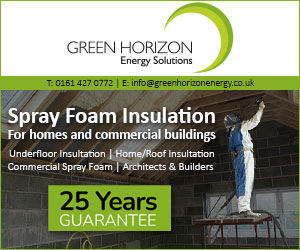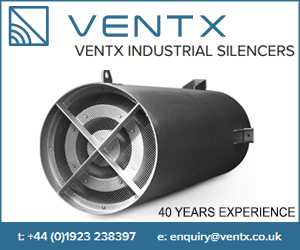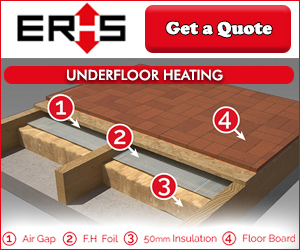Time and date
CONSTRUCTION DIRECTORY
eZero Solutions Ireland Contact Details
Address
Unit 2,
Charvey Lane
Charvey Lane
County Wicklow
Ireland
About eZero Solutions Ireland
Ezero E500 Sprayed polyurethane foam is 100% Water Blown, NSAI Agrément Certified & completely safe
Spray Foam does not emit anything, good or bad. It does not disintegrate, unlike fiberglass, nor does it shrink, settle, or crack. Spray polyurethane foam simply performs for the lifetime of the building without needing service, maintenance, or upgrade.
Scarce resources
Foam is made from petroleum oil in addition to other products from renewable resources, such as polyols, made from sugar and water. It is important to note that the petroleum is not converted to CO2 emissions; instead it is permanently converted to material like artificial wood. Oil formed from decaying forests is now converted to carbon-rich insulation materials.
Global Warming
CO2 footprint related to production and transport
Like any product, insulation foam has a carbon footprint related to its production and transport. However, it is a smaller CO2 footprint than just about any other product. A set of E:zero Spray Foam E:500 consists of two drums containing 110 gallons of fluid. Once sprayed, the volume expands to about 13,000 gallons! In terms of transport-related emissions, this is about 1- 2% of the emissions of other insulation products like fiberglass or cellulose, which are expanded at the production site rather than at the end user site. E:zero is studying the actual cradle to grave CO2 impact of sprayed insulation foam, and will publicise the findings once they become available.
CO2 Footprint while in service
There is none caused by the foam, while CO2 emission savings of the HVAC equipment are triggered. Sprayed insulation foams do not emit anything while in service. In fact, the spray foam insulation reduces carbon emissions of the home by lowering the heating and cooling requirements of the house. Typically, home owners experience heating and cooling-related energy savings of up to 50% compared with traditional insulation. Even higher savings are realised in retrofit situations in previously un-insulated homes. The reduction of carbon emissions is directly proportional to the realized energy savings. In a recent study conducted by E:zero, the carbon footprint of a large old home was reduced by 30,000 lbs. annually. This study is not representative for the majority of homes; however, an annual CO2 reduction between 10,000 and 20,000 lbs. per year is a safe assumption. At a meeting on July 8, 2008, the United States pledged to reduce its carbon emissions by 50% by the year 2050. If all homes in the United States were insulated with E:zero foam, our country would reach its goal for the emissions caused by heating and cooling.
CO2 footprint savings relating to longevity
An often-overlooked fact is that there are carbon emissions caused by products needed to be replaced due to loss of performance or total failure. For example, fibreglass performance suffers as it ages. Serious performance degradation will occur over 10 to 15 years as fibres collapse and are no longer fluffy. Real world uvalue performance may diminish by 30% or more. At this point, fibreglass should be replaced, which is cost-prohibitive. Instead, the vast majority of home owners live with higher energy consumption and correspondingly increasing CO2 emissions. Homes insulated with spray-applied foam insulation fare better; E:zero Spray Foam Insulation will never suffer in performance, and homeowners will thus avoid the cost of replacement and related landfill issues or diminished energy efficiency. A brief survey was carried out on various internet sites indicating the average service life expectancy of homes of at least 75 years: under these assumptions, the estimated savings of CO2 emissions for the lifespan of a foamed 2500 sq. ft single-family home amounts to 750,000 lbs.
Spray Foam does not emit anything, good or bad. It does not disintegrate, unlike fiberglass, nor does it shrink, settle, or crack. Spray polyurethane foam simply performs for the lifetime of the building without needing service, maintenance, or upgrade.
Scarce resources
Foam is made from petroleum oil in addition to other products from renewable resources, such as polyols, made from sugar and water. It is important to note that the petroleum is not converted to CO2 emissions; instead it is permanently converted to material like artificial wood. Oil formed from decaying forests is now converted to carbon-rich insulation materials.
| Energy Efficiency | Environmental Benefits |
 |  |
| Health Benefits | Indoor Air Quality |
 |  |
| Sound Control | e500 Product Details |
 |  |
Global Warming
CO2 footprint related to production and transport
Like any product, insulation foam has a carbon footprint related to its production and transport. However, it is a smaller CO2 footprint than just about any other product. A set of E:zero Spray Foam E:500 consists of two drums containing 110 gallons of fluid. Once sprayed, the volume expands to about 13,000 gallons! In terms of transport-related emissions, this is about 1- 2% of the emissions of other insulation products like fiberglass or cellulose, which are expanded at the production site rather than at the end user site. E:zero is studying the actual cradle to grave CO2 impact of sprayed insulation foam, and will publicise the findings once they become available.
CO2 Footprint while in service
There is none caused by the foam, while CO2 emission savings of the HVAC equipment are triggered. Sprayed insulation foams do not emit anything while in service. In fact, the spray foam insulation reduces carbon emissions of the home by lowering the heating and cooling requirements of the house. Typically, home owners experience heating and cooling-related energy savings of up to 50% compared with traditional insulation. Even higher savings are realised in retrofit situations in previously un-insulated homes. The reduction of carbon emissions is directly proportional to the realized energy savings. In a recent study conducted by E:zero, the carbon footprint of a large old home was reduced by 30,000 lbs. annually. This study is not representative for the majority of homes; however, an annual CO2 reduction between 10,000 and 20,000 lbs. per year is a safe assumption. At a meeting on July 8, 2008, the United States pledged to reduce its carbon emissions by 50% by the year 2050. If all homes in the United States were insulated with E:zero foam, our country would reach its goal for the emissions caused by heating and cooling.
CO2 footprint savings relating to longevity
An often-overlooked fact is that there are carbon emissions caused by products needed to be replaced due to loss of performance or total failure. For example, fibreglass performance suffers as it ages. Serious performance degradation will occur over 10 to 15 years as fibres collapse and are no longer fluffy. Real world uvalue performance may diminish by 30% or more. At this point, fibreglass should be replaced, which is cost-prohibitive. Instead, the vast majority of home owners live with higher energy consumption and correspondingly increasing CO2 emissions. Homes insulated with spray-applied foam insulation fare better; E:zero Spray Foam Insulation will never suffer in performance, and homeowners will thus avoid the cost of replacement and related landfill issues or diminished energy efficiency. A brief survey was carried out on various internet sites indicating the average service life expectancy of homes of at least 75 years: under these assumptions, the estimated savings of CO2 emissions for the lifespan of a foamed 2500 sq. ft single-family home amounts to 750,000 lbs.
















